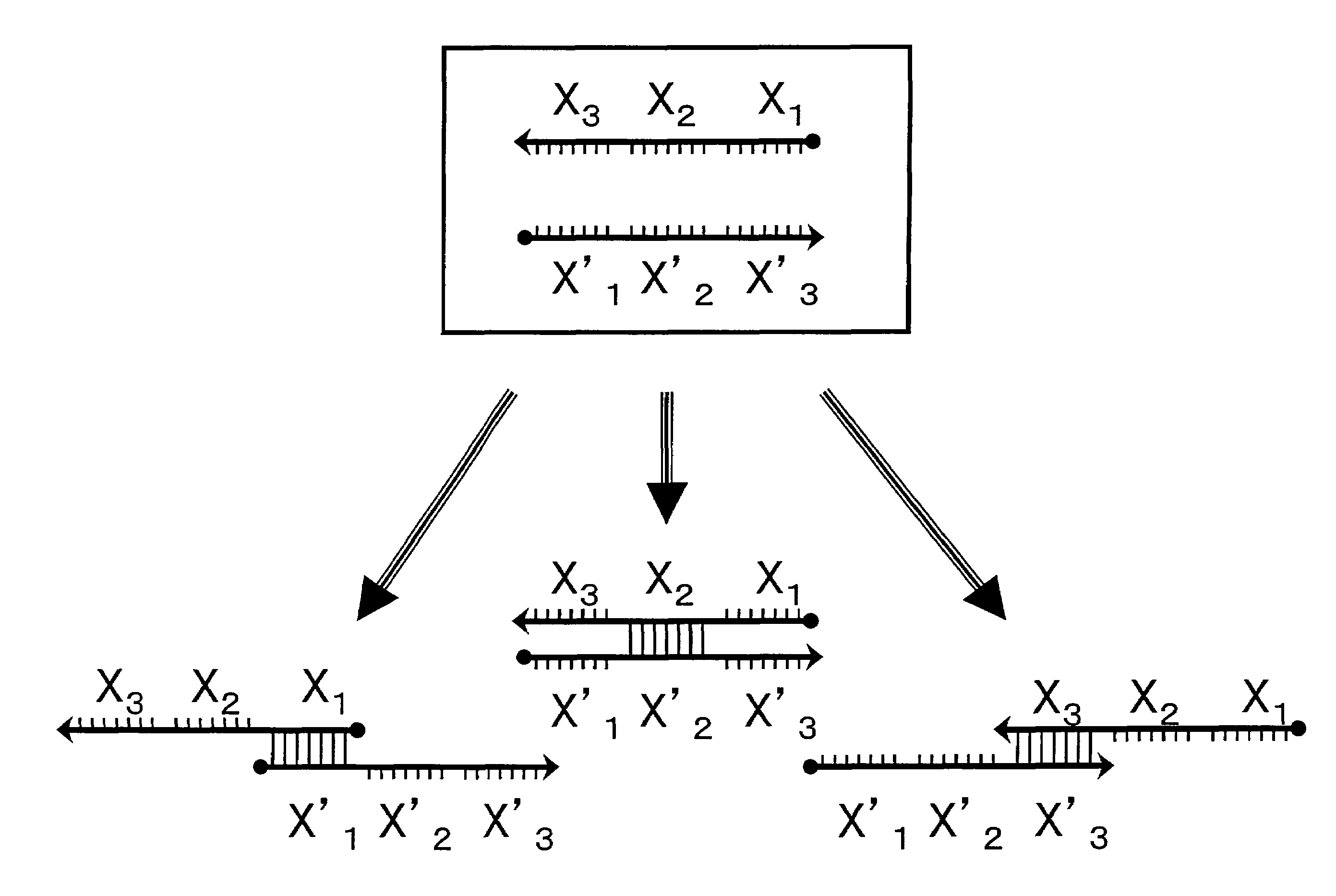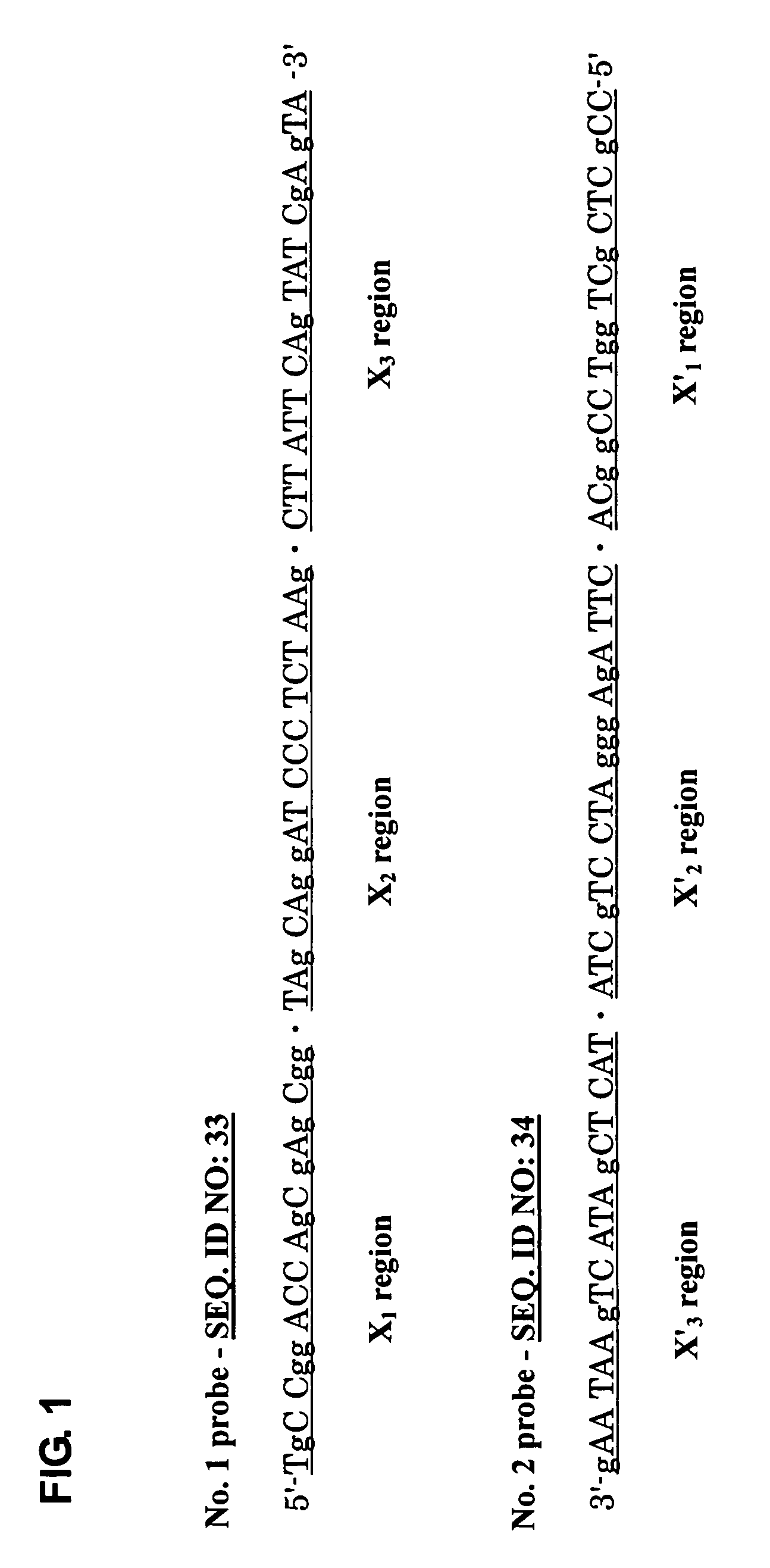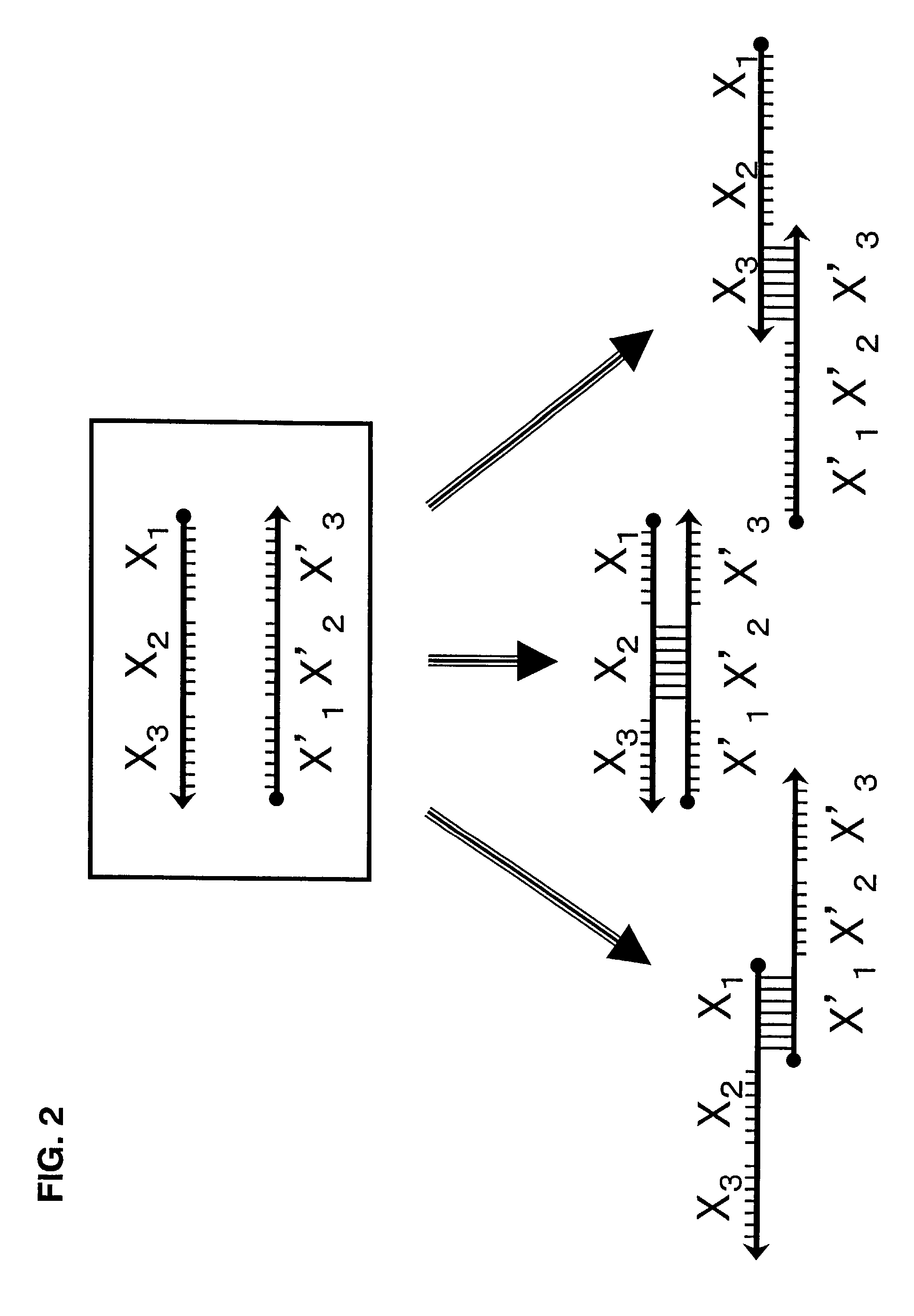Probe for constructing probe-polymer method of constructing probe-polymer and utilization thereof
a probe-polymer and probe-polymer technology, applied in the field of probe-polymer construction probe-polymer methods of constructing probe-polymer and utilization thereof, can solve the problems of time loss, above techniques require an expensive enzyme, isothermal nucleic acid amplification methods, etc., to improve the stacking effect, stabilize the double helix structure, and strengthen the hybridization reaction
- Summary
- Abstract
- Description
- Claims
- Application Information
AI Technical Summary
Benefits of technology
Problems solved by technology
Method used
Image
Examples
example 1
1. Object
[0152]The effect of polymerization with respect to hybridization temperature was proved using polymerization probes which are a pair of DNA probes according to the present invention.
2. Materials
[0153]1) Probes 1 and 2 were used in polymerization.
[0154]2) 20×SSC (3 M-NaCl, 0.3 M-C6H5O7Na3.2H2O, pH 7.0) was used as a buffer solution.
3. Procedure
[0155]5 μL of the probes 1 and 2 each prepared to be 1013 copies / μL were added in 0.2 mL sterilized microtubes respectively, then 40 μL of 20×SSC were further added, and those microtubes were covered with a lid. Then, those microtubes were boiled at 94° C. for 30 seconds and warmed at 50° C., 52° C., 54° C., 56° C., 58° C., 60° C., 64° C., 66° C., 68° C. and 70° C. for 30 minutes, respectively.
[0156]After the warming, electrophoresis was performed using 0.5% agarose gel to confirm the effect of the polymerization through ethidium bromide staining.
4. Results
[0157]FIG. 27 is a photograph showing the results of Example 1 with electrophore...
example 2
1. Object
[0160]It was proved that a polymer polymerized by polymerization probes, i.e., a pair of DNA probes according to the present invention can be cleaved by a restriction enzyme.
2. Materials
[0161]1) Probes 3 and 4 were used in polymerization.
[0162]2) Hae III (made by Takara Shuzo Co., Ltd.) was used as a restriction enzyme.
[0163]3) M-Buffer (made by Takara Shuzo Co., Ltd.) was used as a buffer solution for the restriction enzyme.
[0164]4) 20×SSC was used as a buffering solution.
3. Procedure
[0165]5 μL of the probes 3 and 4 each prepared to be 1013 copies / μL were added in a 0.2 mL sterilized microtube respectively, then 5 μL of 20×SSC and 35 μL of sterilized distilled water were further added to produce a reaction solution A, and the microtube was covered with a lid. Similarly to the reaction solution A, 2.5 μL of the probes 3 and 4 each prepared to be 1013 copies / μL were added in a 0.2 mL sterilized microtube respectively, then 5 μL of 20×SSC and 40 μL of sterilized distilled wat...
example 3
1. Materials
[0169]1) Probes 5 and 6 were used in polymerization.
[0170]2) Magnetic beads bound with streptavidin (product name: Streptavidin MagneSphere made by Promega, Inc.) was used for a solid phase for B / F separation.
[0171]3) 20×SSC and 0.5×SSC (40-times diluent of 20×SSC) were used as buffer solutions.
2. Procedure
[0172]10 μL each of synthetic HCV-RNA prepared to be 101 copies / 10 μL, 102 copies / 10 μL, 103 copies / 10 μL, 104 copies / 10 μL, 105 copies / 10 μL, 106 copies / 10 μL, 107 copies / 10 μL, 108 copies / 10 μL, 109 copies / 10 μL, and 1010 copies / 10 μL were added in a 0.2 mL sterilized microtube, respectively. Then, 1 μL each of the HCV-RNA capture probe B, probe C, probe D and probe E prepared to be 1013 copies / μL, 10 μL of the probe 5 prepared to be 1013 copies / μL, and 25 μL of 20×SSC were added, respectively. The respective microtubes were covered with a lid, and the ingredients were mixed by a mixer and warmed at 62° C. for 60 minutes.
[0173]Once the temperature lowered to room tem...
PUM
| Property | Measurement | Unit |
|---|---|---|
| pH | aaaaa | aaaaa |
| temperature | aaaaa | aaaaa |
| temperature | aaaaa | aaaaa |
Abstract
Description
Claims
Application Information
 Login to View More
Login to View More - R&D
- Intellectual Property
- Life Sciences
- Materials
- Tech Scout
- Unparalleled Data Quality
- Higher Quality Content
- 60% Fewer Hallucinations
Browse by: Latest US Patents, China's latest patents, Technical Efficacy Thesaurus, Application Domain, Technology Topic, Popular Technical Reports.
© 2025 PatSnap. All rights reserved.Legal|Privacy policy|Modern Slavery Act Transparency Statement|Sitemap|About US| Contact US: help@patsnap.com



